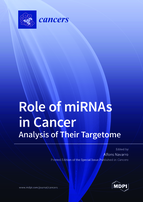Role of miRNAs in Cancer—Analysis of Their Targetome
A special issue of Cancers (ISSN 2072-6694).
Deadline for manuscript submissions: closed (31 March 2020) | Viewed by 52128
Special Issue Editor
2. August Pi i Sunyer Biomedical Research Institute (IDIBAPS), 08036 Barcelona, Spain
3. Thoracic Oncology Unit, Hospital Clinic, 08036 Barcelona, Spain
Interests: noncoding RNAs; microRNAs; piwiRNAs; lncRNAs; circularRNAs; extracellular vesicles; exosomes; biomarkers; lung cancer; colorectal cancer; lymphoma; leukemia
Special Issues, Collections and Topics in MDPI journals
Special Issue Information
Dear Colleagues,
It is now becoming increasingly apparent that the nonprotein-coding portion of the genome is of crucial functional importance, both for normal physiology and for disease. MicroRNAs (miRNAs) are the best studied noncoding RNA sequences of our genome. Since the discovery of the second miRNA sequence, let-7a, in 2000, the identification of new miRNAs has increased considerably. In fact, as of 2019, we know of more than 2675 mature miRNAs in humans (according to miRBase v22.1). The first evidence that miRNAs were related to cancer also came from let-7a, which was described as a tumor suppressor in 2002. Since then, it has become clear that miRNA expression is dysregulated in human cancers. In order to identify the functions of the dysregulated miRNAs, it is necessary to decipher their target genes. Although multiple individual miRNA targets have been identified, very few studies have evaluated the targetome of specific miRNAs, which would provide us with a broader vision. Moreover, several studies have recently reported that miRNAs also target other noncoding RNAs, playing an important regulatory role of the noncoding RNA compartment. Finally, miRNAs have been shown to play a role not only in tumor cells but also in other cells, where they are transported through exosomes. The screening of exosomal miRNAs and the evaluation of their functions outside the tumor warrant further study to clarify the importance of these extracellular miRNAs in tumor progression and especially in metastasis. The identifications of their targets will also be crucial.
More efforts are still needed to decipher the critical targets—both coding and noncoding RNAs—of the miRNAs involved in cancer and to identify their contribution to malignant transformation and metastasis. The present issue will focus on the identification of the functions of tumorigenic miRNAs through the study of their targetome in both tumor and nontumor cells, where they are transported through exosomes. The large-scale identification of miRNA targets will allow a greater understanding of the complex networks regulated by miRNAs.
Dr. Alfons Navarro
Guest Editor
Manuscript Submission Information
Manuscripts should be submitted online at www.mdpi.com by registering and logging in to this website. Once you are registered, click here to go to the submission form. Manuscripts can be submitted until the deadline. All submissions that pass pre-check are peer-reviewed. Accepted papers will be published continuously in the journal (as soon as accepted) and will be listed together on the special issue website. Research articles, review articles as well as short communications are invited. For planned papers, a title and short abstract (about 100 words) can be sent to the Editorial Office for announcement on this website.
Submitted manuscripts should not have been published previously, nor be under consideration for publication elsewhere (except conference proceedings papers). All manuscripts are thoroughly refereed through a single-blind peer-review process. A guide for authors and other relevant information for submission of manuscripts is available on the Instructions for Authors page. Cancers is an international peer-reviewed open access semimonthly journal published by MDPI.
Please visit the Instructions for Authors page before submitting a manuscript. The Article Processing Charge (APC) for publication in this open access journal is 2900 CHF (Swiss Francs). Submitted papers should be well formatted and use good English. Authors may use MDPI's English editing service prior to publication or during author revisions.
Keywords
- microRNAs
- targetome
- AGO-CLIP
- deep sequencing
- exosomes
- extracellular vesicles







